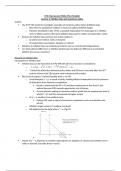Notes de cours
HT2 Sticky Price Models Notes
- Cours
- Établissement
These notes were prepared based on the lectures and supplemented by information from textbooks and tutorials where parts of the lecture were unclear. Graphs, equations, and bullet-point explanations included. Prepared by a first class Economics and Management student for the FHS Macroeconomics pape...
[Montrer plus]



